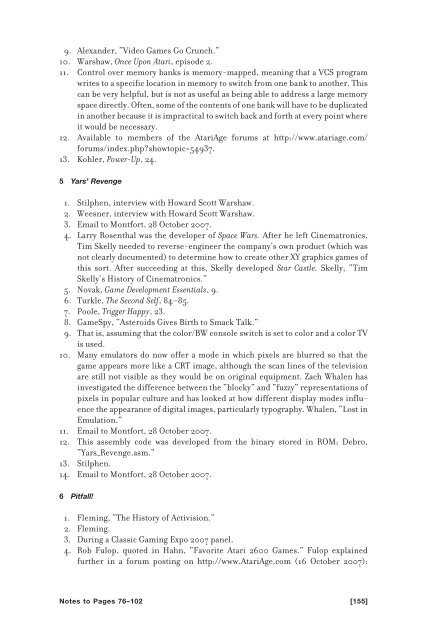Racing the Beam : the Atari Video Computer System - Index of
Racing the Beam : the Atari Video Computer System - Index of
Racing the Beam : the Atari Video Computer System - Index of
You also want an ePaper? Increase the reach of your titles
YUMPU automatically turns print PDFs into web optimized ePapers that Google loves.
9. Alexander, “<strong>Video</strong> Games Go Crunch.”<br />
10. Warshaw, Once Upon <strong>Atari</strong>, episode 2.<br />
11. Control over memory banks is memory-mapped, meaning that a VCS program<br />
writes to a specifi c location in memory to switch from one bank to ano<strong>the</strong>r. This<br />
can be very helpful, but is not as useful as being able to address a large memory<br />
space directly. Often, some <strong>of</strong> <strong>the</strong> contents <strong>of</strong> one bank will have to be duplicated<br />
in ano<strong>the</strong>r because it is impractical to switch back and forth at every point where<br />
it would be necessary.<br />
12. Available to members <strong>of</strong> <strong>the</strong> <strong>Atari</strong>Age forums at http://www.atariage.com/<br />
forums/index.php?showtopic=54937.<br />
13. Kohler, Power-Up, 24.<br />
5 Yars’ Revenge<br />
1. Stilphen, interview with Howard Scott Warshaw.<br />
2. Weesner, interview with Howard Scott Warshaw.<br />
3. Email to Montfort, 28 October 2007.<br />
4. Larry Rosenthal was <strong>the</strong> developer <strong>of</strong> Space Wars. After he left Cinematronics,<br />
Tim Skelly needed to reverse-engineer <strong>the</strong> company’s own product (which was<br />
not clearly documented) to determine how to create o<strong>the</strong>r XY graphics games <strong>of</strong><br />
this sort. After succeeding at this, Skelly developed Star Castle. Skelly, “Tim<br />
Skelly’s History <strong>of</strong> Cinematronics.”<br />
5. Novak, Game Development Essentials, 9.<br />
6. Turkle, The Second Self, 84–85.<br />
7. Poole, Trigger Happy, 23.<br />
8. GameSpy, “Asteroids Gives Birth to Smack Talk.”<br />
9. That is, assuming that <strong>the</strong> color/BW console switch is set to color and a color TV<br />
is used.<br />
10. Many emulators do now <strong>of</strong>fer a mode in which pixels are blurred so that <strong>the</strong><br />
game appears more like a CRT image, although <strong>the</strong> scan lines <strong>of</strong> <strong>the</strong> television<br />
are still not visible as <strong>the</strong>y would be on original equipment. Zach Whalen has<br />
investigated <strong>the</strong> difference between <strong>the</strong> “blocky” and “fuzzy” representations <strong>of</strong><br />
pixels in popular culture and has looked at how different display modes infl uence<br />
<strong>the</strong> appearance <strong>of</strong> digital images, particularly typography. Whalen, “Lost in<br />
Emulation.”<br />
11. Email to Montfort, 28 October 2007.<br />
12. This assembly code was developed from <strong>the</strong> binary stored in ROM; Debro,<br />
“Yars_Revenge.asm.”<br />
13. Stilphen.<br />
14. Email to Montfort, 28 October 2007.<br />
6 Pitfall!<br />
1. Fleming, “The History <strong>of</strong> Activision.”<br />
2. Fleming.<br />
3. During a Classic Gaming Expo 2007 panel.<br />
4. Rob Fulop, quoted in Hahn, “Favorite <strong>Atari</strong> 2600 Games.” Fulop explained<br />
fur<strong>the</strong>r in a forum posting on http://www.<strong>Atari</strong>Age.com (16 October 2007):<br />
Notes to Pages 76–102 [155]


